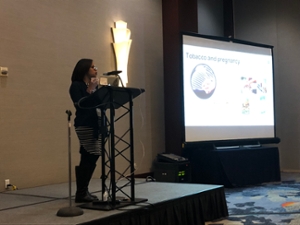TRDRP values effective communication of science to the public as a tool to inform non-scientists and policymakers about current, accurate research findings relating to tobacco use prevention, cessation, and tobacco-related diseases.
TRDRP recently provided predoctoral and postdoctoral grantees with an opportunity to enhance their skills to communicate research in a clear and engaging way to a non-technical audience. The trainees’ efforts were put into practice at the first TRDRP Trainee Showcase at the international Society for Research on Nicotine and Tobacco (SRNT) annual conference in San Francisco on February 21. The presentations were well-received by over one hundred attendees, stimulating audience questions and lively discussions at the reception.
Prior to the Showcase, trainees were coached on presenting their research to a general scientific audience by Bri McWhorter of Activate to Captivate. Ms. McWhorter has coached graduate student contestants in the UC Grad Slam as well as scientists at several UC campuses. She worked with TRDRP trainees to craft simple scientific presentations, focus on concepts with general audience appeal, and use images to effectively communicate their research. Participants were enthusiastic about the training as an opportunity to maximize the public impact of their work.
The Trainee Showcase @ SRNT supports two of TRDRP’s core values, to (1) advance the careers of researchers from diverse backgrounds interested in tobacco-related research and to (2) communicate research findings to a diverse array of stakeholders. TRDRP will continue to seek opportunities to prepare grantees to effectively communicate research findings to a non-technical audience.
Summaries of each presentation are listed below:
- Shannon Lea Watkins, PhD, a postdoctoral fellow at UCSF presented “Menthol, mango, and crème brûlée: The role of flavors in the tobacco epidemic.” Her research demonstrates that flavored tobacco products appeal to young people who would not have otherwise experimented with tobacco, potentially leading to a life-long nicotine addiction. This insight informs efforts to implement flavored tobacco bans, such as the one passed in San Francisco in June 2018.
- Joe Zhang, PhD, a postdoctoral fellow at Stanford University presented “Our Genes & Nicotine: How gene variation affects cardiac function.” He described a genetic mutation that increases the risk for nicotine dependence, cancer and cardiovascular disease after exposure to nicotine, and demonstrated its detrimental effect on the normal function of cardiomyocytes, the cells that make up the heart. Understanding the genetic basis for nicotine-mediated heart disease will lead to more targeted medical interventions and ultimately more effective medical therapy.
- Nicole Sparks, PhD, who conducted her predoctoral, and now postdoctoral research at UC Riverside presented “Bad to the Bone: How tobacco affects skeletal development.” In her research she exposed early embryonic cells in a culture dish to certain presumed harm reduction tobacco products, and showed that this exposure impaired the development of cells that form the skeleton. Demonstrating that tobacco products labeled as “harm reducing” may injure developing offspring is important when deciding how to counsel pregnant mothers about tobacco cessation.
- Matthew Stone, a graduate student at UC San Diego presented “Graphic Warnings on Cigarette Packs: What's the Cost?” His research demonstrated that smokers would require significant price discounts to willingly purchase cigarettes packaged with graphic warning labels relative to the standard US cigarette packs, which contain tobacco marketing. Whether to require cigarettes to display graphic warning labels on their packages has long been debated in the U.S. Mr. Stone’s research provides evidence that graphic warning labels could be a disincentive for smokers in the US to purchase cigarettes and thus decrease the smoking rate further.
- Sreelakshmi Vasudevan, PhD, a postdoctoral fellow at UCSF presented “How does smoking affect the lung's cleanup crew?” Her research compared macrophages (a type of immune cell) in lungs of healthy individuals and those with Chronic Obstructive Pulmonary Disease (COPD), a smoking-related lung disease that makes it more and more difficult to breathe over time. She found that in the lungs of healthy people, there is a balance between how macrophages fight infection and how they clean up the leftover debris after the infection has been cleared. In lungs of COPD patients, however, she found that there are fewer cleanup macrophages and more that fight infection. Since too many infection-fighting macrophages can lead to more inflammation and debris, this has led her to hypothesize that COPD may be treated by increasing the lung’s cleanup macrophages and better controlling those macrophages that fight infection. These insights could form the basis for a novel treatment for COPD, a disease for which few treatments currently exist.
- Adam Witmer, a graduate student at UC Riverside presented “Breaking Down Data Barriers with Deep Learning.” His research is focused on teaching computers (deep learning) to identify microscopic differences in cells that have been treated with a potentially toxic substance. By teaching computers to identify and record small differences in cellular behavior, rather than using standard laboratory techniques, cell-based assays would become faster and more reliable than they currently are. Mr. Witmer is piloting this deep learning by treating cells with nicotine and observing their behavior. His research could lead to faster results from toxicology assays or screens for therapeutic drugs.

